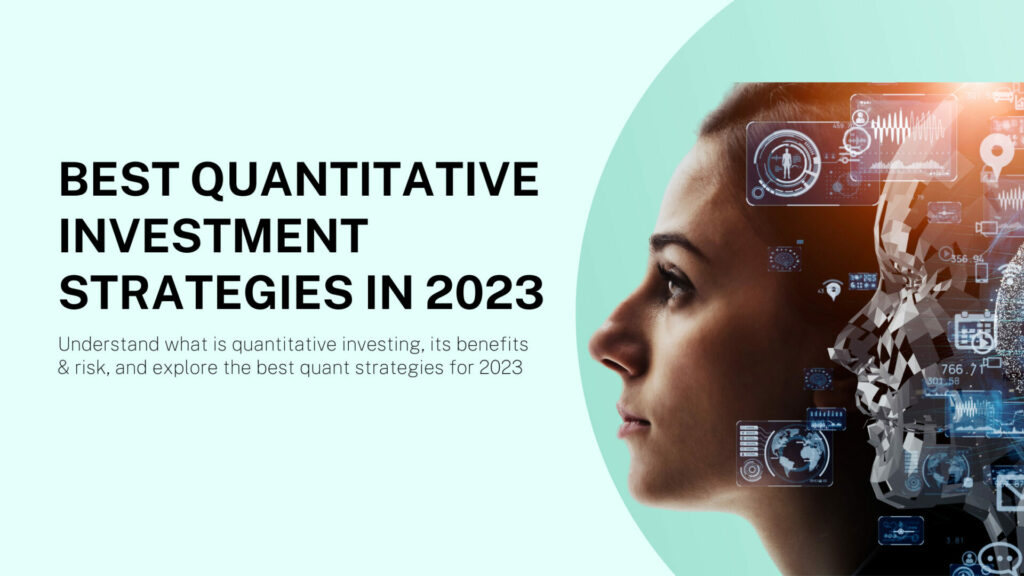Best Quantitative Investment Strategies of 2023

The widespread application of quantitative investment strategies is a relatively recent trend. Over the past few decades, the field of quant investing has made significant advancements in the world of finance. Additionally, the field has been evolving to create new investment technologies that ultimately simplify the process. This article will provide you with a better understanding of quant investing and how it can be implemented for better decision-making and increased portfolio returns.
Understanding Quantitative Investment Strategies
What is quantitative investing?
Quantitative investing, often known as systematic investing, utilizes mathematical models and computations to pinpoint lucrative investment opportunities. By harnessing statistical methodologies, sophisticated algorithms, and a wealth of data, this form of investing minimizes human bias and allows for more impartial decision-making. It relies more on empirical evidence than personal intuition or relying on your gut.
This systematic process neutralizes human biases that often affect judgement. Emotions like fear and greed are eliminated from the decision-making equation, leading to actions based on the statistical probability of profit. As a result, the data-centric and emotion-free approach of systematic investing typically yields more consistent and dependable outcomes.
Quantitative Investing can refer to a broad spectrum of investment strategies, ranging from the fast moving world of high-frequency trading that takes place within microseconds, to long-term strategies where the same portfolio is held for over a year or more. Essentially, a quant fund is any strategy that heavily employs quantitative techniques to guide investment decisions. Human participation is typically limited to creating the investment tools and models.
What is a quantitative investing strategy?
A quantitative investing strategy employs sophisticated mathematical models to analyze financial markets and identify optimal trading opportunities. Constructed using historical financial data and market trends, these strategies can be tailored to suit various investment goals, risk tolerances, and market situations, offering flexible tools for investment management.
Quantitative investing strategies are built by professionals, including programmers, statisticians, and investment analysts, with the objective of identifying stocks that are more likely to outperform an index based on a range of characteristics. There are various models available, each considering different factors. Quantitative techniques also aid in asset allocation and risk management, aligning portfolios with the client’s needs. Early adopters are now leveraging alternative data sources and machine-learning models, a branch of artificial intelligence (AI), to interpret vast amounts of information, aiding in more informed investment decisions. For instance, historical headcount data could be analyzed to track a company’s growth, providing insights into its size and hiring patterns. Market sentiment by analyzing social media posts, twitter commentaries, financial performance data can be quickly analyzed with the use of AI to build better and more refined quantitative investing strategies.
Although quantitative investing has historically been the realm of sophisticated hedge funds, the commoditization of computational power and data storage has seen traditional institutional investors, fundamental funds, portfolio management advisors, robo advisors and many more incorporate quantitative techniques into their trading and portfolio allocation decisions. Robo advisors, such as Wright Research, are leveraging quantitative models along with AI and deep learning to build robust quantitative investing strategies.
Benefits of Quantitative Investment Strategies
Quantitative investment methods offer a plethora of advantages. These methods curtail the influence of emotions and biased judgement, leading to a more regimented approach.
- Quantitative investing is evidence-based, implying more predictable outcomes, particularly in terms of the expected risk and return profile. Hence, they can be better tailored to meet various investors’ needs. Once developed, quantitative models can be effortlessly and economically tested on different markets, with or without any modifications.
- Through systematically examining massive amounts of data, they can reveal insights and relationships that may be overlooked in conventional analysis.
- Furthermore, they enable swift trade execution and alterations in response to fluctuating market circumstances.
- Quantitative methods also provide superior risk management features, as they can be designed to consider several risk factors concurrently.
- As quant trading choices are computer model-driven, they remain unaffected by human emotions. Fear and greed often influence individuals’ investment decisions, impacting both the inception and closure of positions. This is where discipline often poses a challenge for investors. Interestingly, quantitative investing can exploit irrational decision-making in the marketplace.
- Compact teams of quantitative analysts can handle an extensive array of securities – cue robo advisors. They can cover a wide range of sectors, regions, and countries without the need to onboard new analysts or have hundreds of people working to invest capital across assets. Quant teams can be lean, have faster response time and find more opportunities to discover securities poised for outperformance.
Drawbacks of Quantitative Investing
Regardless of its advantages, quantitative investing has its own set of hurdles. The fact that quantitative funds are managed without any discretion can be a mixed blessing. While the unemotional nature of decision-making is advantageous in most cases, there are times when it can be a drawback.
- Creating and implementing quantitative models necessitate profound mathematical and computational competencies. The strategy’s success is profoundly influenced by the quality and relevance of the data utilized. Garbage in, garbage out – incorrect inputs can provide incorrect outcomes.
- Overfitting is a potential risk when models are overly adapted to past data, impairing their predictive abilities.
- While funds with a strong momentum bias can harness the performance of growth stocks, those based on other factors will likely overlook high-growth stocks.
- As quant strategies are built on anticipated return distribution and probabilities, a reasonably large number of holdings is necessary, which can lead to return dilution.
- Regulatory adherence and handling tech-related risks like cybersecurity are additional challenges confronted by quantitative investors.
- Quant strategies generally need long timeframes to show results and often lag behind their benchmark over shorter durations. However, this doesn’t apply to all quant funds, and novel data sources are currently being employed to develop models that yield alpha in the short term.
Quant investors and traders hold a pragmatic understanding that no strategy is perfect. They acknowledge that even a model that has been successful in the past may lose its profitability due to changes in market conditions, regulatory adjustments, or shifts in economic landscapes. This realisation motivates them to continually fine-tune and adapt their strategies.
Best Quantitative Investment Strategies for 2024
Quantitative investment strategies have surged in popularity in recent years, thanks to advancements in computational capabilities and data analysis techniques. These strategies rely heavily on mathematical models and automated algorithms to make investment decisions. Let’s dive deeper into some of the promising quantitative investment strategies expected to yield significant results in 2024.
Best Quantitative Investment Strategies 2024 #1: Factor-Based Investing
This strategy involves identifying factors (such as size, value, momentum, and volatility) that have historically contributed to a higher return on investment. By leveraging these factors, investors can optimize their portfolio for better performance. For example, a momentum based strategy might involve investing in stocks that have been performing well recently with the expectation that they’ll continue to do so in the near future. Value investing, another popular strategy, focuses on stocks that are undervalued by the market and thus are expected to provide above-average returns when the market corrects.
Best Quantitative Investment Strategies 2024 #2: Alternative Data Strategies
Quantitative strategies using alternative data are rapidly gaining popularity. This approach involves leveraging non-traditional data sources, such as social media sentiment, satellite imagery, credit card transaction data, or web traffic data, to make investment decisions. These unconventional data sets offer unique insights that can provide a competitive edge in investment decision-making. For example, an alternative data strategy might use sentiment analysis on social media platforms to gauge public opinion about a particular company or product. This information can provide valuable insights into potential market movements and inform timely investment decisions.
Best Quantitative Investment Strategies 2024 #3: Machine Learning and Artificial Intelligence
Machine learning models can analyze enormous datasets, identify patterns, and make predictions, which can be used to guide investment decisions. AI can also adapt to new data and self-improve, making it a powerful tool for investment strategy development. Two prominent approaches within ML strategies include supervised and unsupervised learning. Supervised learning algorithms make predictions based on labelled historical data, allowing them to forecast future market trends or stock prices. Unsupervised learning, on the other hand, discovers hidden patterns and relationships in unlabeled data, providing new perspectives on potential investment opportunities.
Best Quantitative Investment Strategies 2024 #4: Risk Parity Strategies
Risk Parity strategies are anticipated to continue their success in 2024 as they did in 2023. This approach aims to distribute risk evenly across various asset classes to achieve a balanced portfolio. The objective is not to maximize returns but rather to achieve steady, consistent returns while minimizing portfolio volatility. Risk parity strategies leverage advanced algorithms to regularly rebalance the portfolio based on changing market conditions and volatility levels. This ensures that each asset class’s contribution to the overall portfolio risk remains constant, offering a stable investment route for risk-averse investors.
In conclusion, the strategies mentioned above are expected to be the frontrunners in quantitative investing for 2024. However, it’s crucial to understand that every investment strategy comes with its own set of risks. Therefore, investors should choose strategies aligning with their risk tolerance and investment goals. They should also be open to leveraging emerging technologies and data sources to stay competitive in this rapidly evolving field.
Check out Wright Momentum smallcase here!
Wryght Research & Capital Pvt Ltd•SEBI Registration No: INA100015717
103, Shagun Vatika Prag Narayan Road, Lucknow, UP 226001 IN
CIN: U67100UP2019PTC123244
Disclaimer: Investment in securities market are subject to market risks. Read all the related documents carefully before investing. Registration granted by SEBI, membership of BASL and certification from NISM in no way guarantee performance of the intermediary or provide any assurance of returns to investors. The content in these posts/articles is for informational and educational purposes only and should not be construed as professional financial advice and nor to be construed as an offer to buy/sell or the solicitation of an offer to buy/sell any security or financial products. Users must make their own investment decisions based on their specific investment objective and financial position and use such independent advisors as they believe necessary.
Disclosures: Link





